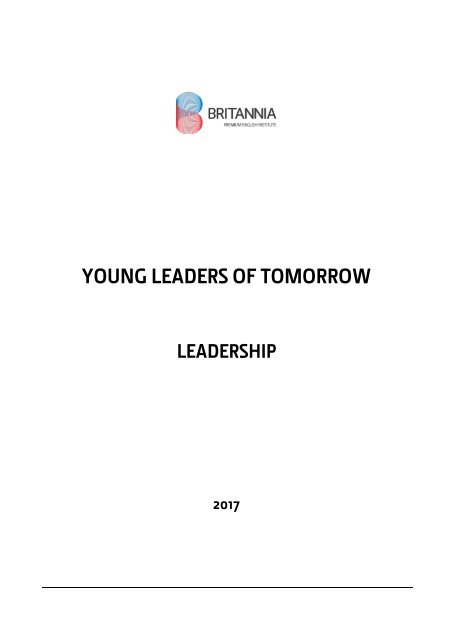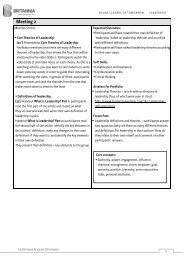Pages from Young Leaders - Leadership-2
Este arquivo inclui material do curso "Young Leaders of tomorrow", módulo Leadership. As páginas foram selecionadas aleatóriamente. O único objetivo deste documento é dar aos interessados uma idéia do conteúdo do curso. Este material inclui parte do planejamento, assim como material distribuido em sala de aula e não é o material completo.
Este arquivo inclui material do curso "Young Leaders of tomorrow", módulo Leadership. As páginas foram selecionadas aleatóriamente. O único objetivo deste documento é dar aos interessados uma idéia do conteúdo do curso.
Este material inclui parte do planejamento, assim como material distribuido em sala de aula e não é o material completo.
You also want an ePaper? Increase the reach of your titles
YUMPU automatically turns print PDFs into web optimized ePapers that Google loves.
YOUNG LEADERS OF TOMORROW<br />
LEADERSHIP<br />
2017
YOUNG LEADERS OF TOMORROW<br />
LEADERSHIP<br />
BRITANNIA – <strong>Young</strong> <strong>Leaders</strong> of Tomorrow – <strong>Leaders</strong>hip<br />
Module Objectives:<br />
By the end of the <strong>Leaders</strong>hip Module, participants will:<br />
• have a better understanding of the core concepts of leadership<br />
• have a better understanding of the responsibilities of a leader;<br />
• have improved their ability to communicate with a team;<br />
• have developed a capacity for thinking critically about leadership behaviors and understanding how leadership<br />
theories relate to life;<br />
• be better able to understand and evaluate their personal strengths and challenges as leaders in everyday life.<br />
Course Structure<br />
Meeting 1<br />
• Getting to know each other<br />
• Introduction of the course and objectives<br />
• <strong>Leaders</strong>hip quotes<br />
Meeting 2<br />
• Core <strong>Leaders</strong>hip Theories<br />
• <strong>Leaders</strong>hip definitions<br />
Meeting 3<br />
• Types of leader<br />
Meeting 7<br />
• Preparation and planning for final presentations<br />
Meeting 8<br />
• Ethics, integrity and moral responsibility<br />
Meeting 9<br />
• Personal SWOT analysis<br />
Meeting 4<br />
• Characteristics of a good leader<br />
Meeting 5<br />
• Developing one’s emotional intelligence<br />
Meeting 6<br />
• <strong>Leaders</strong>hip: Culture and Context<br />
Meeting 10<br />
• How to stand out as leaders<br />
Meeting 11<br />
External Lecturer + Internal Teacher<br />
• Lecture<br />
Meeting 12<br />
• Final presentations<br />
THE BRITANNIA ACADEMIC DEPARTMENT<br />
2
YOUNG LEADERS OF TOMORROW<br />
LEADERSHIP<br />
Meeting 2<br />
MEETING STAGES:<br />
• Core Theories of <strong>Leaders</strong>hip:<br />
(20’) Presentation Core Theories of <strong>Leaders</strong>hip:<br />
Facilitator mentions that there are many different<br />
theories of leadership, then shows the four that will be<br />
mentioned in the video (slide 1). Participants watch the<br />
video (slide 2) and make notes on each theory. As this is a<br />
watching activity, you may want to tell students to write<br />
down some key words in order to guide their note taking.<br />
After watching the video, in groups of three, participants<br />
compare notes and rank the theories <strong>from</strong> the one that<br />
makes most sense to them to the least.<br />
• Definitions of leadership:<br />
(35’) Handout What is <strong>Leaders</strong>hip? Part 1: participants<br />
read the first part of the article and, based on what<br />
they’ve read and watched, write their own definition of<br />
leadership in pairs.<br />
Handout What is <strong>Leaders</strong>hip? Part 2: participants read<br />
the second half of the article, identify the key elements in<br />
the authors’ definition, make any changes to their own<br />
definitions if they want to, and identify the key elements<br />
in their own definition.<br />
They present their definition + key elements to the group.<br />
Expected Outcomes:<br />
• Participants will have created their own definition of<br />
‘leadership’ based on leadership theories and an article<br />
with different definitions;<br />
• Participants will have ranked leadership theories according<br />
to their own views.<br />
Soft Skills:<br />
• Collaboration and teamwork;<br />
• Communication skills;<br />
• Critical thinking.<br />
Artefact for Portfolio:<br />
• <strong>Leaders</strong>hip Theories – article with six theories of<br />
leadership (four of which were seen in class).<br />
http://www.businessnewsdaily.com/3647-leadershipdefinition.html<br />
Forum Post:<br />
• <strong>Leaders</strong>hip definitions and theories – participants answer<br />
two questions (why are there so many different theories<br />
and definitions for leadership in their opinion? How do<br />
they relate to their own view?) and comment on other<br />
participants’ answers.<br />
Core concepts:<br />
• Authority, power, engagement, influence,<br />
charisma, management, vision, empower, goal,<br />
seniority, position, hierarchy, senior executives,<br />
titles, personal attributes.<br />
THE BRITANNIA ACADEMIC DEPARTMENT<br />
6
YOUNG LEADERS OF TOMORROW<br />
LEADERSHIP<br />
Meeting 3<br />
MEETING STAGES:<br />
• Types of leaders:<br />
(10’)Presentation The Tree: Participants watch the video<br />
and answer the questions that pop up at the end in groups<br />
of three.<br />
Facilitator elicits general outcomes of their discussions<br />
and link it with different types of leaders.<br />
(20’ - preparation) Facilitator then divides the<br />
participants into four groups. Each group will read about<br />
one different type of leader to then present it to the class.<br />
Each group will use the types of leaders (Thought /<br />
Courageous / Inspirational / Servant) as basis to create a<br />
kind of crosswords with the key words to define the type<br />
of leader they’re reading about. They don’t necessarily<br />
need to use all the letters in the main word. This is an<br />
example:<br />
Expected Outcomes:<br />
• Participants will have read about a type of leader;<br />
• Participants will have presented and listened to<br />
presentations about different types of leaders.<br />
Soft Skills:<br />
• Information Literacy;<br />
• Communication skills;<br />
• Creativity.<br />
Artefact for Portfolio:<br />
• The eight most common types of leaders.<br />
http://www.colibrifacilitation.com/graphic-facilitationtips/8-most-common-types-of-leaders-which-type-areyou/<br />
Core concepts:<br />
• Influence, followers, vision, mission, taking risks,<br />
values, core beliefs, convictions, motivate, ideals,<br />
positive attitudes, potential, empower,<br />
development.<br />
Participants will write this in A4 paper and then they will<br />
show it to the whole class and present their type of<br />
leader.<br />
(20’ - presentation)After each presentation, each group<br />
should come up with a question about the presentation.<br />
The group presenting doesn’t necessarily have to answer<br />
the question, but all the participants in class should<br />
discuss it together.<br />
• If you have extra time:<br />
Refer participants back to the boy in the video, and have<br />
them discuss in small groups what kind of leader the boy<br />
might be, and why.<br />
THE BRITANNIA ACADEMIC DEPARTMENT<br />
7
YOUNG LEADERS OF TOMORROW<br />
LEADERSHIP<br />
Meeting 6<br />
MEETING STAGES:<br />
• Culture and context:<br />
(10’)Use presentation <strong>Leaders</strong>hip: culture and context to<br />
engage participants on the topic – use slide 2 as a whole<br />
group discussion.<br />
(25’)Show participants slide 3 of the presentation and<br />
check if they know the people in the slide. They may know<br />
some. Tell them they will read fact files about 3 of these<br />
people and they’ll discuss in groups of 4 the questions on<br />
slide 4.<br />
Give away one page of the handout per participant, but<br />
make sure participants in the same group get the same<br />
page so that they talk about the same people (Handout<br />
Fact files) .Tell them they may use their mobiles during<br />
the discussion moment to gather more information about<br />
the people.<br />
(15’)Show slide 5. This is a starting question for a broader<br />
discussion for the whole group. Be the mediator and play<br />
the devil’s advocate role if needed to keep the debate<br />
going. Encourage participants to use the people they read<br />
about as examples. Help them give their own opinions<br />
based on evidence.<br />
Expected Outcomes:<br />
• Participants will have read about different young people<br />
who are influencers in different contexts;<br />
• Participants will have debated on the importance of<br />
culture and context for leadership.<br />
Soft Skills:<br />
• Citizenship;<br />
• Critical thinking;<br />
• Communication skills;<br />
• Cultural awareness.<br />
Artefacts for Portfolio:<br />
• How culture influences leaders<br />
http://www.romania-insider.com/leadership-stylehow-does-culture-influence-leaders/<br />
• What’s cultural awareness and how to build it<br />
http://www.culturosity.com/articles/whatisculturalawa<br />
reness.htm<br />
• How cultural factors affect leadership<br />
http://knowledge.wharton.upenn.edu/article/howcultural-factors-affect-leadership/<br />
Forum post:<br />
• Participants discuss the link between emotional<br />
intelligence and cultural awareness, and how they can be<br />
beneficial to a successful leader.<br />
Core concepts:<br />
• Activism, self-awareness, goals, mindset, empathy,<br />
influence, inspire, culture, context, background.<br />
THE BRITANNIA ACADEMIC DEPARTMENT<br />
10
Forbes Online<br />
APR 9, 2013 @ 10:06 AM<br />
What is<br />
<strong>Leaders</strong>hip?<br />
What is leadership, anyway?<br />
Such a simple question, and yet it continues to vex 1 popular consultants and lay people<br />
alike. I’ve now written several books on leadership for employee engagement, and yet it<br />
occurred to me that I never actually paused to define leadership. Let’s start with what<br />
leadership is not…<br />
<strong>Leaders</strong>hip has nothing to do with seniority or one’s position in<br />
the hierarchy of a company. Too many talk about a company’s leadership<br />
referring to the senior most executives in the organization. They are<br />
just that, senior executives. <strong>Leaders</strong>hip doesn’t automatically happen<br />
when you reach a certain pay grade. Hopefully you find it there, but<br />
there are no guarantees.<br />
<strong>Leaders</strong>hip has nothing to do with titles. Similar to the point above,<br />
just because you have a C-level title 2 , doesn’t automatically make you a<br />
“leader.” In all of my talks I stress the fact that you don’t need a title to<br />
lead. In fact, you can be a leader in your place of worship 3 , your neighborhood,<br />
in your family, all without having a title.<br />
<strong>Leaders</strong>hip has nothing to do with personal attributes. Say the<br />
word “leader” and most people think of a domineering, take-charge<br />
charismatic individual. We often think of icons <strong>from</strong> history like General<br />
Patton or President Lincoln. But leadership isn’t an adjective. We don’t<br />
need extroverted charismatic traits 4 to practice leadership. And those<br />
with charisma don’t automatically lead.<br />
Kevin Kruse is the creator of<br />
the Leading for Employee Engagement<br />
eLearning program for managers.<br />
and author of the bestselling<br />
book, Employee Engagement 2.0.<br />
Glossary<br />
1. Vex (v.) to make someone<br />
annoyed, confused, or worried<br />
2. C-level title The highest-level<br />
executives in senior management<br />
usually have titles beginning with<br />
"chief" forming what is often<br />
called the C-suite. The traditional<br />
three such officers are chief<br />
executive officer (CEO), chief<br />
operations officer (COO), and chief<br />
financial officer (CFO)<br />
3. Worship (n.) the activity of<br />
showing respect and love for a<br />
god, for example by singing or<br />
praying<br />
4. Trait (n.) a distinguishing quality<br />
or characteristic in someone's<br />
character<br />
<strong>Young</strong> <strong>Leaders</strong> of Tomorrow—<strong>Leaders</strong>hip<br />
1
<strong>Leaders</strong>hip isn’t management. This is the big one. <strong>Leaders</strong>hip and<br />
management are not synonymous. You have 15 people in your<br />
downline 5 and P&L responsibility 6 ? Good for you, hopefully you are a<br />
good manager. Good management is needed. Managers need to plan,<br />
measure, monitor, coordinate, solve, hire, fire, and so many other things.<br />
Typically, managers manage things. <strong>Leaders</strong> lead people.<br />
So, again, what is <strong>Leaders</strong>hip?<br />
Let’s see how some of the most respected business thinkers of our time define<br />
leadership, and let’s consider what’s wrong with their definitions.<br />
Peter Drucker: “The only definition of a leader is someone who<br />
has followers.”<br />
Really? This instance of tautology 7 is so simplistic as to be dangerous. A<br />
new Army Captain is put in the command of 200 soldiers. He never<br />
leaves his room, or utters 8 a word to the men and women in his unit.<br />
Perhaps routine orders are given through a subordinate. By default his<br />
troops have to “follow” orders. Is the Captain really a leader?<br />
Commander yes, leader no. Drucker is of course a brilliant thinker of<br />
modern business but his definition of leader is too simple.<br />
Glossary<br />
5. Downline People recruited by a<br />
salesperson to work as<br />
salespeople for this first person.<br />
They generate profit for<br />
themselves and for the person<br />
who first hired them. This is a<br />
marketing strategy called<br />
Multi-level marketing (MLM)<br />
6. P&L responsibility Profit and Loss<br />
(P&L) responsibility is one of the<br />
most important responsibilities of<br />
any executive position. Having<br />
P&L responsibility involves<br />
monitoring the net income after<br />
expenses for a department or<br />
entire organization, with direct<br />
influence on how company<br />
resources are allocated.<br />
7. Tautology (n.) UK /tɔːˈtɒl.ə.dʒi/ US<br />
/tɑːˈtɑː.lə.dʒi/ a statement, sentence<br />
etc in which the meaning is<br />
repeated in an unnecessary way<br />
by using different words<br />
8. Utter (v.) to say something or to<br />
make a sound with your voice<br />
9. Riot (n.) a noisy, violent, and<br />
uncontrolled public meeting<br />
10. Hooligan (n.) a violent person<br />
who fights or causes damage in<br />
public places<br />
Warren Bennis: “<strong>Leaders</strong>hip is the capacity to translate vision<br />
into reality.”<br />
Every spring you have a vision for a garden, and with lots of work carrots<br />
and tomatoes become a reality. Are you a leader? No, you’re a gardener.<br />
Bennis’ definition seems to have forgotten “others.”<br />
Bill Gates: “As we look ahead into the next century, leaders will<br />
be those who empower others.”<br />
This definition includes “others” and empowerment is a good thing. But<br />
to what end? I’ve seen many empowered “others” in my life, <strong>from</strong><br />
rioting 9 hooligans 10 to Google workers who were so misaligned with the<br />
rest of the company they found themselves unemployed. Gates’<br />
definition lacks the parts about goal or vision.<br />
<strong>Young</strong> <strong>Leaders</strong> of Tomorrow—<strong>Leaders</strong>hip<br />
2
John Maxwell: “<strong>Leaders</strong>hip is influence – nothing more, nothing<br />
less.”<br />
I like minimalism but this reduction is too much. A robber with a gun has<br />
“influence” over his victim. A manager has the power to fire team<br />
members which provides a lot of influence. But does this influence make<br />
a robber or a manager a leader? Maxwell’s definition omits the source 11<br />
of influence.<br />
Glossary<br />
11.Source (n.) UK /sɔːs/ US /sɔːrs/<br />
the place something comes <strong>from</strong><br />
or starts at, or the cause of something<br />
12. Discretionary UK /dɪˈskreʃ.ən.ər.i/<br />
US /dɪˈskreʃ.ən.er.i/ based on<br />
someone’s judgment of a particular<br />
situation rather than on a set<br />
of rules<br />
So what is leadership?<br />
DEFINITION: <strong>Leaders</strong>hip is a process of social influence, which<br />
maximizes the efforts of others, towards the achievement of a goal.<br />
Notice key elements of this definition:<br />
<strong>Leaders</strong>hip stems <strong>from</strong> social influence, not authority or power<br />
<strong>Leaders</strong>hip requires others, and that implies they don’t need to be<br />
“direct reports”<br />
No mention of personality traits, attributes, or even a title; there are<br />
many styles, many paths, to effective leadership<br />
It includes a goal, not influence with no intended outcome<br />
Lastly, what makes this definition so different <strong>from</strong> many of the<br />
academic definitions out there is the inclusion of “maximizes the<br />
efforts”. Most of my work is in the area of employee engagement, and<br />
engaged employees give discretionary 12 effort.<br />
I guess technically a leader could use social influence to just organize the<br />
efforts of others, but I think leadership is about maximizing the effort.<br />
It’s not, “Hey everyone, let’s line up and get to the top of that hill<br />
someday.” But rather, “Hey, see that hill? Let’s see how fast we can get<br />
to the top…and I’ll buy the first round for anyone who can beat me up<br />
there.” So what do you think of my definition of leadership? Social<br />
influence, others, maximize effort, towards a goal. Do those key<br />
elements work for you?<br />
<strong>Young</strong> <strong>Leaders</strong> of Tomorrow—<strong>Leaders</strong>hip<br />
3
Use the questions below to build your own SWOT:<br />
Strengths<br />
• What unique skills do you have?<br />
• What do you do better than anyone else?<br />
• What unique resources can you access?<br />
• Why do people praise you?<br />
• What achievements are you porud of?<br />
• What values do you believe in?<br />
Opportunities<br />
• What opportunities to learn are open?<br />
• What situations can you take advantage of?<br />
• Do you have people to help/advise you?<br />
• Are there any emerging technologies that<br />
could help my idea?<br />
• Have you any solutions to others’<br />
complaints?<br />
• Is there a unfilled need around you?<br />
Weaknesses<br />
• What skills/knowledge do you lack?<br />
• What skills can you improve?<br />
• What do you avoid doing?<br />
• What do others see as your weaknesses?<br />
• What are your negative habits?<br />
• What personality traits hold you back?<br />
Threats<br />
• What obstacles do you currently face?<br />
• Is the demand for your strengths declining?<br />
• What trends could harm your projects?<br />
• Does changing technology affect my idea?<br />
• What threats arise <strong>from</strong> your weaknesses?<br />
YLOT - LEADERSHIP











